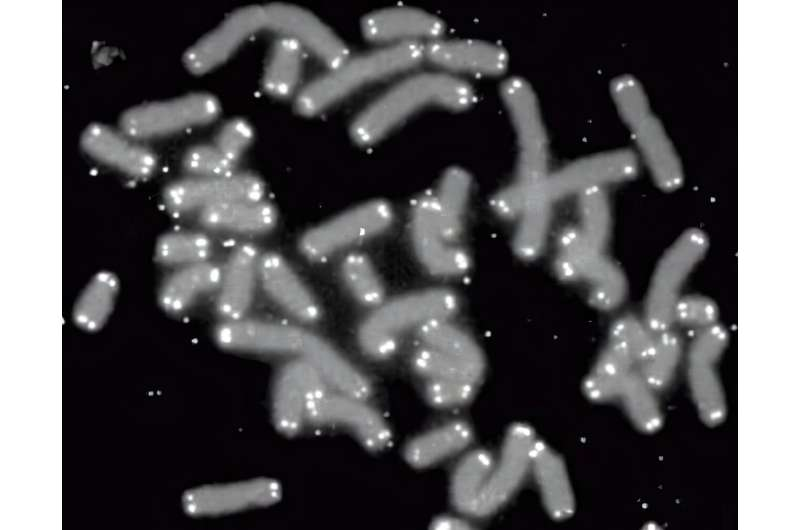Bacterial 'jumping genes' can target and control chromosome ends
In a paper published in Science, researchers show that transposons can target and insert themselves at the ends of linear chromosomes, called telomeres, within their bacterial host. In Streptomyces—historically one of the most significant bacteria for antibiotic development—they found that transposons controlled the telomeres in nearly a third of the chromosomes.
"This is a big part of their biology," said senior author Joseph Peters, professor of microbiology. "Bacteria are like these little tinkerers. They're always collecting these mobile DNA pieces, and they're making new functions all the time—everything in antibiotic resistance is really about mobile genetic elements and almost always transposons that can move between bacteria."
With some technologies not available even five years ago, the researchers identified several families of transposons in cyanobacteria and Streptomyces that, using different mechanisms, can find and insert themselves at the telomere, with benefits for the transposon and their bacterial host.
For one, inserting at the end of the chromosome helps the transposon avoid genes for the cell's core functioning, which reside in the middle of the chromosomes; transposons that can target the ends are less likely to disrupt an essential function or cause cell death.
"If you could target the end, you're less likely to knock out something that the host wants, and then these ends, by various systems, are transferred between cells," Peters said.
"For any element to survive—a transposon, bacteria—they really need to be able to do those two things: they need to not cause too much damage, and they need a way to move to new hosts. By inserting into the telomeres, they're able to do both."
Transposons have been found clustered at the chromosome ends in eukaryotic cells, but this is the first time it's been documented in bacteria with linear chromosomes, and the researchers found that bacterial transposons (versus eukaryotes) use unique mechanisms to control the telomeres.
Transposons are usually flanked by protein-binding sequences that indicate where to excise the DNA element and move it to a new location. In Streptomyces, researchers observed that the transposons at the telomeres were one-sided, with a traditional transposon sequence on one end with the other end being the telomere. This functionally allows the transposon to be the telomere, making it essential to the cell generally.
"What it lets them do is become essential to the host, because they now control the telomere, and if the element got deleted along with this system, the host would die," Peters said.
The researchers found one subfamily of telomere-targeting transposons that coopted a CRISPR system—normally used by bacteria to defend against viruses—to target and insert itself into the chromosome ends. This process is further confirmation of previous research in Peters' lab that found transposons using CRISPR systems to move around genomes, opening the potential for a new gene-editing tool that would allow for larger sections of DNA to be inserted than the now widely used CRISPR-Cas9.
"The transposons keep grabbing these systems and coopting them in different ways," Peters said. "In this paper, we explained a new one of these elements using a CRISPR-Cas system to target the telomeres."
The insights—especially into Streptomyces, which is difficult to manipulate in the lab and accounts for the discovery of many of our antibiotics—could prove useful for drug development, as transposons drive bacterial evolution and may direct researchers to new antibiotics and other useful products encoded on these transposons.
"Most of life on the planet is microbes, and specifically bacteria," Peters said. "We want to understand how these living organisms function, but then we want to see how we can use these systems for the betterment of humankind."
Gene expression, Genetic mutation, DNA sequencing, Genome mapping, Epigenetics, CRISPR technology, Gene therapy, Genetic variation, Transcription factors, Molecular genetics, RNA interference, Genetic engineering, Genomic stability, Inherited disorders, Chromosome structure, Functional genomics, Genetic polymorphism, Non-coding RNA, Epigenetic regulation, Gene regulation
#GeneExpression #GeneticMutation #DNASequencing #GenomeMapping #Epigenetics #CRISPR #GeneTherapy #GeneticVariation #TranscriptionFactors #MolecularGenetics #RNAi #GeneticEngineering #GenomicStability #InheritedDisorders #ChromosomeStructure #FunctionalGenomics #GeneticPolymorphism #NonCodingRNA #EpigeneticRegulation #GeneRegulation
International Conference on Genetics and Genomics of Diseases
Visit: genetics-conferences.healthcarek.com
Award Nomination: genetics-conferences.healthcarek.com/award-nomination/?ecategory=Awards&rcategory=Awardee
Award registration: genetics-conferences.healthcarek.com/award-registration/
For Enquiries: contact@healthcarek.com
Get Connected Here
---------------------------------
---------------------------------
in.pinterest.com/Dorita0211
twitter.com/Dorita_02_11_
facebook.com/profile.php?id=61555903296992
instagram.com/p/C4ukfcOsK36
genetics-awards.blogspot.com/
youtube.com/@GeneticsHealthcare

Comments
Post a Comment